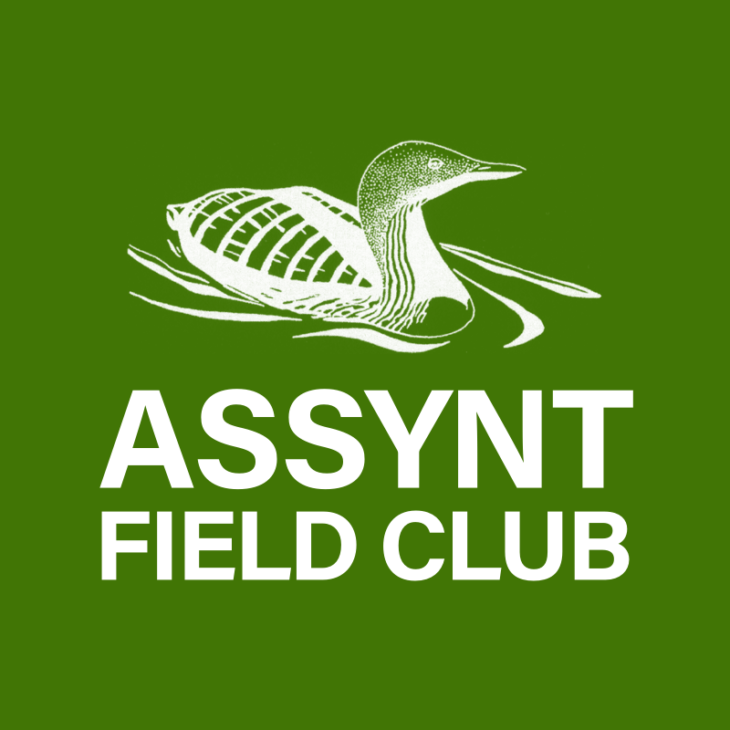What to Spot: January Edition
,
2020 has arrived! January is a time when a lot of our species are just trying to make it through winter. Food is a little scarcer and the pressure simply to survive, to keep breeding grounds or to migrate back home is increasing.
David mentioned garden birds last month and January is still a good time to attract creatures close to home as they search for food. This month is also great for looking out for ducks, raptors and owls which can be easier to spot because of the early darkness! Here are some suggested species to look out for.
 A common sight in southern areas but shyer and more concealed in Coigach and Assynt is the Little Grebe (aka dabchick). Although here all year round, less vegetation means they are a little easier to find on inland lochs such as Loch na Claise, Loch an Aigeil, Little Assynt or Loch Culag.
A common sight in southern areas but shyer and more concealed in Coigach and Assynt is the Little Grebe (aka dabchick). Although here all year round, less vegetation means they are a little easier to find on inland lochs such as Loch na Claise, Loch an Aigeil, Little Assynt or Loch Culag.
Little Grebes (Tachybaptus ruficollis) are rarely seen on land as their feet are placed towards the back of their body to help with swimming underwater. Listen out for a ‘plop’ as they dive into the water, to pop up a little distance further away.
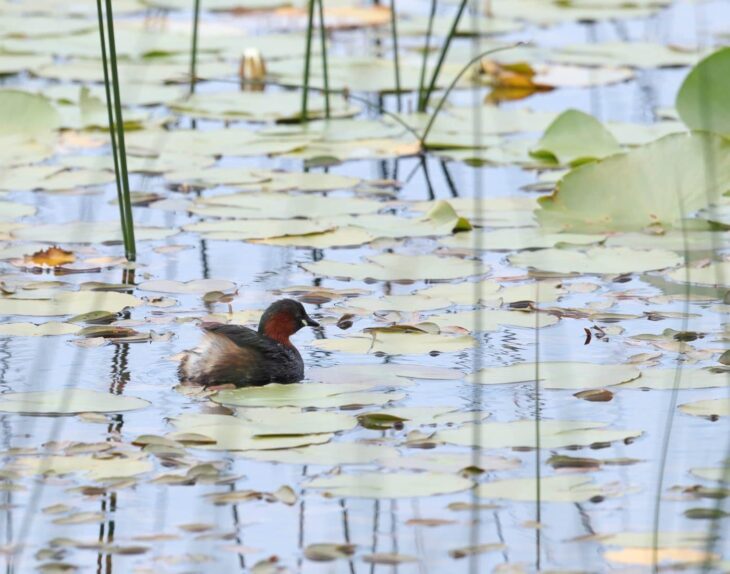
A coastal bird to look out for is the Fulmar (Fulmaris glacialis), a common resident breeder to Assynt in particular. They are a type of petrel, nesting on cliff faces along our coast.
Try and look out for these at Stoer Head Lighthouse or the Point of Stoer. They can be seen gliding on the up currents of the cliffs and resting on rocky outcrops.
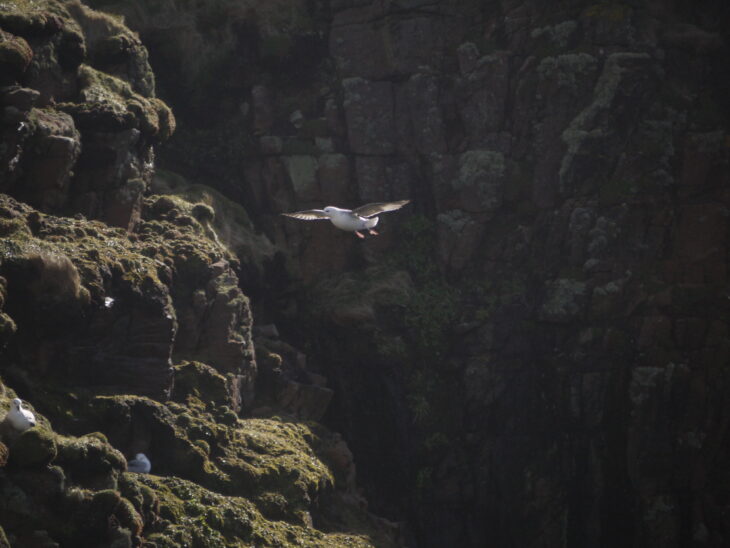
 The Goldeneye (Bucephala clangula, aka the ‘whistler’ after the sound it makes during flight) is a regular winter visitor to the CALL area, with only a very small number breeding in Scotland. Males are particularly distinctive with their black and white feathers and golden eyes.
The Goldeneye (Bucephala clangula, aka the ‘whistler’ after the sound it makes during flight) is a regular winter visitor to the CALL area, with only a very small number breeding in Scotland. Males are particularly distinctive with their black and white feathers and golden eyes.
Inland lochs are your best bet for spotting these Northern European ducks. Try Loch na Claise or Loch an Aigeil, Clachtoll.
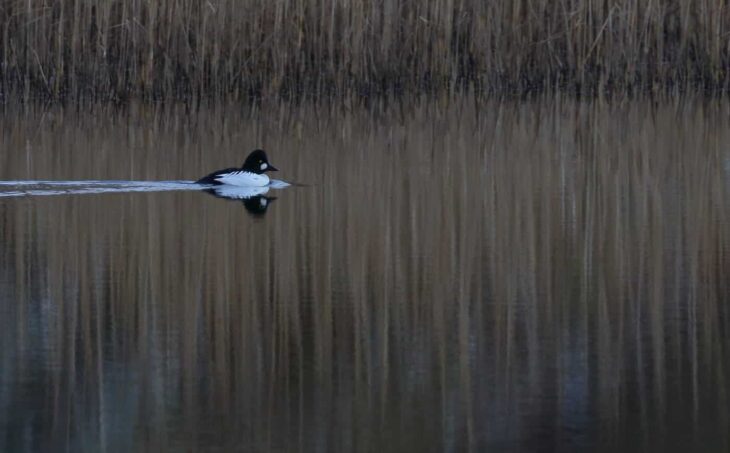
One of the prettiest (and smallest) ducks that winter with us is the Teal (Anas crecca). Small numbers are resident but most migrate from the cold climates of the Baltic and Siberia. Interestingly a group of Teal are called a ‘spring’ as they take off suddenly and vertically when startled.
Try the Bay of Clachtoll, Little Assynt lochs or Oldany Estuary for a glimpse of these fantastic little ducks.
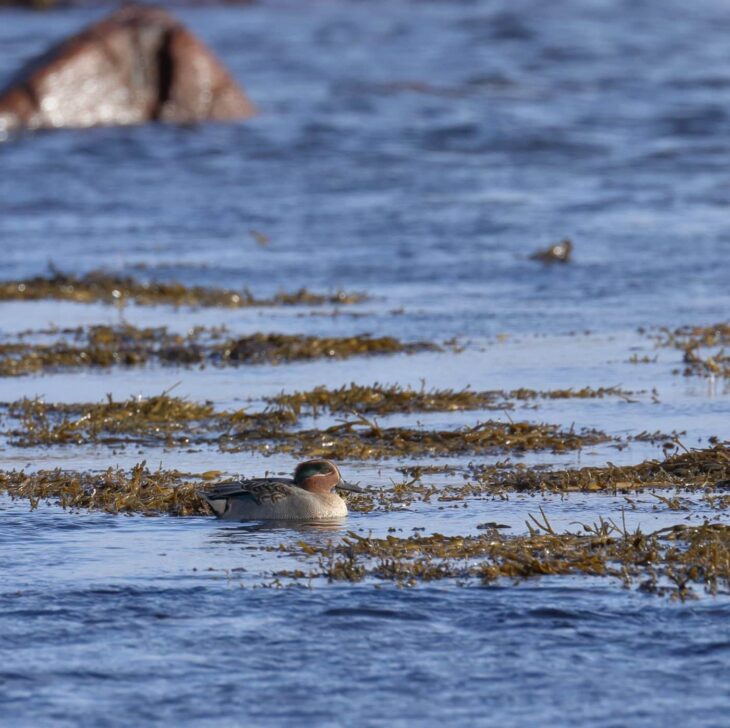
 We are lucky in that Twite (Carduelis flavinostris) can be seen all year round within Coigach and Assynt thanks to our areas of machair providing lots of seeds to support some over winter. They are currently on the Red List of endangered species due to a decline in populations, likely due to a decline in machair or feeding sources.
We are lucky in that Twite (Carduelis flavinostris) can be seen all year round within Coigach and Assynt thanks to our areas of machair providing lots of seeds to support some over winter. They are currently on the Red List of endangered species due to a decline in populations, likely due to a decline in machair or feeding sources.
Stoer, Clachtoll or Achmelvich would be a good place to start looking. Where there is machair, keep an eye out for the sparrow sized birds with their forked tails.
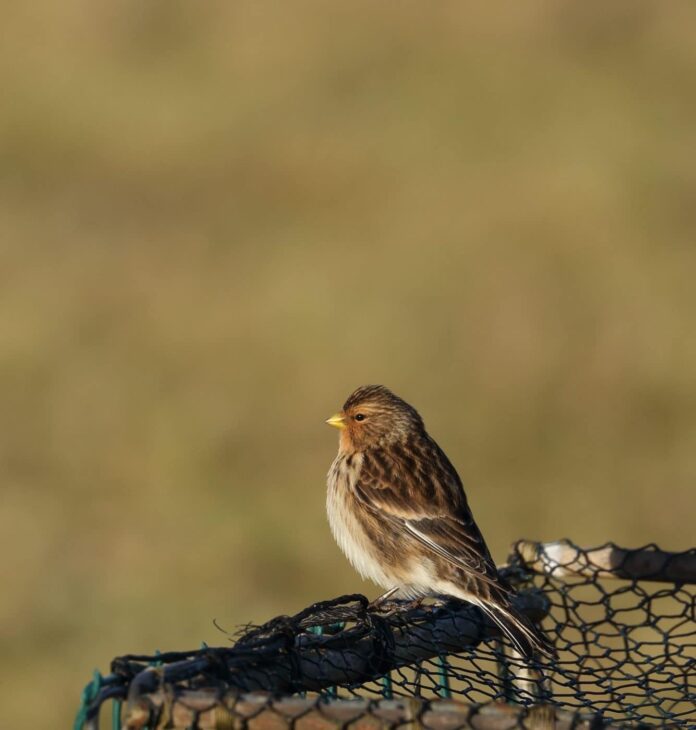
 Often heard and not seen, the Great Spotted Woodpecker (Dendrocopos major) is resident to CALL but in small numbers. Nut feeders seem to be their weakness!
Often heard and not seen, the Great Spotted Woodpecker (Dendrocopos major) is resident to CALL but in small numbers. Nut feeders seem to be their weakness!
Culag Woods have a few residents but bird feeders are often the easiest way to see them.
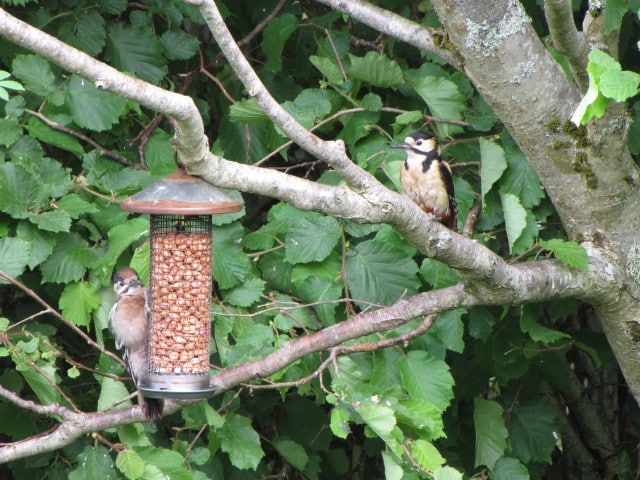
The Snow Bunting (Plectrophenax nivalis) is a rare summer breeder, being joined by winter visitors from Scandinavia and Greenland. During the winter they often look less snowy with an orange buff to their white feathers.
Generally, Snow Bunting can begin arriving in September and stay until March/April although they move according to weather and food sources if needs be.
Sightings have been recorded at Stoer Lighthouse, Loch Assynt, Ledmore Quarry and near Loch Awe.
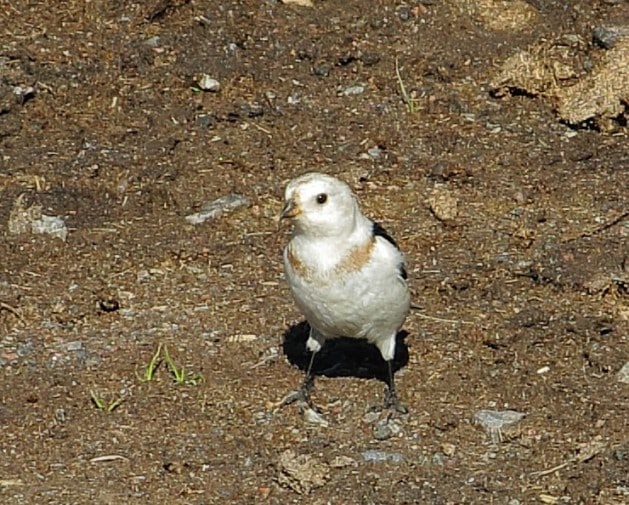
 Another beautiful pale bird to look out for during the dark evenings is the Barn Owl (Tyto alba). Even if driving, their ghostly white silhouette stands out against the surroundings, allowing us a little glimpse into their world. Small numbers are resident to Coigach and Assynt with several owl boxes placed around the area thanks to the Highlife Highland Rangers and residents.
Another beautiful pale bird to look out for during the dark evenings is the Barn Owl (Tyto alba). Even if driving, their ghostly white silhouette stands out against the surroundings, allowing us a little glimpse into their world. Small numbers are resident to Coigach and Assynt with several owl boxes placed around the area thanks to the Highlife Highland Rangers and residents.
Sometimes it’s a case of being in the right place at the right time, but barn owls have been recorded in Inchnadamph, Little Assynt and Achlochan for starters.
An owl you may hear rather than see would be the Tawny Owl (Strix aluco) as they are currently hooting for territories. They can mainly be seen in Assynt and do breed within CALL.
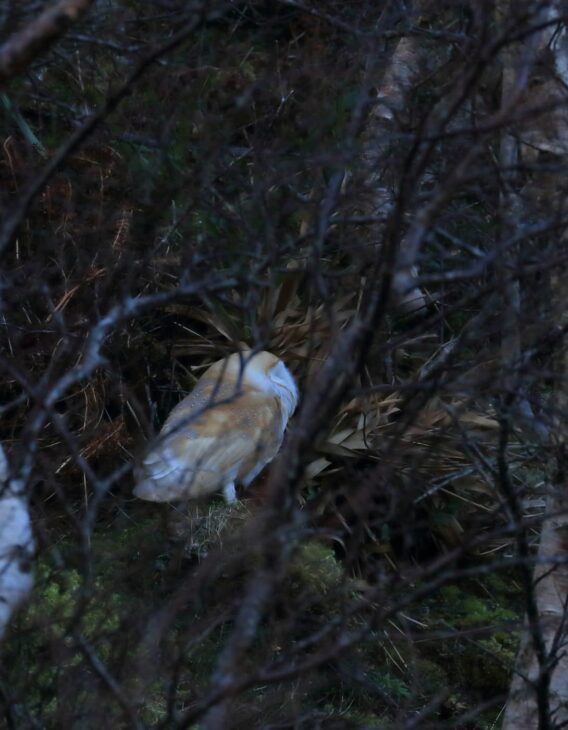
Black Guillemots (Cepphus grille) are definitely one of my favourite birds, I’m not 100% sure why, I just love seeing them bobbing along on the sea with their little red feed paddling hard under the surface. They are quite beautiful in their own way.
Black guillemots also nest on cliff faces and feed out at sea (have a look for them when out on a boat or ferry). Any view of the sea could allow you to see these, just be aware that although they are black as their name suggests, they will be mottled or even almost white in winter.
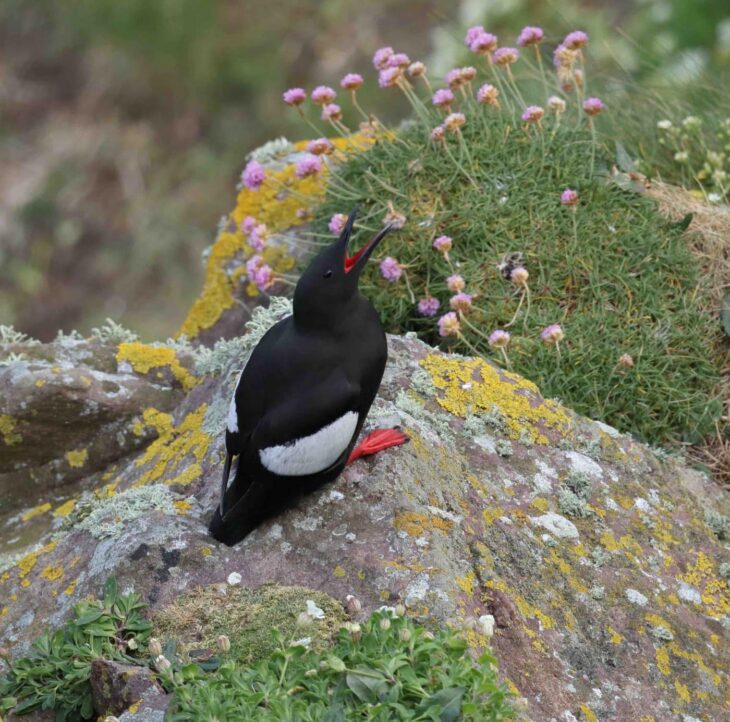
Along side the birds, mammals may be easier to spot this month as they are out hunting for the last berries or small rodents. When there is snow on the ground, look at tracks in the snow. You can often tell what has visited your garden just by the footprints in the morning!
Stoats (Mustella erminea) can be seen all year round but during winter in Coigach and Assynt, and other cold climate areas, Stoats can turn white with a black tip to their tail (ermine). This can range from full white to patchy, like an Arctic Hare. Their main prey is rabbits and they will often take over rabbit or badger borrows as their own.
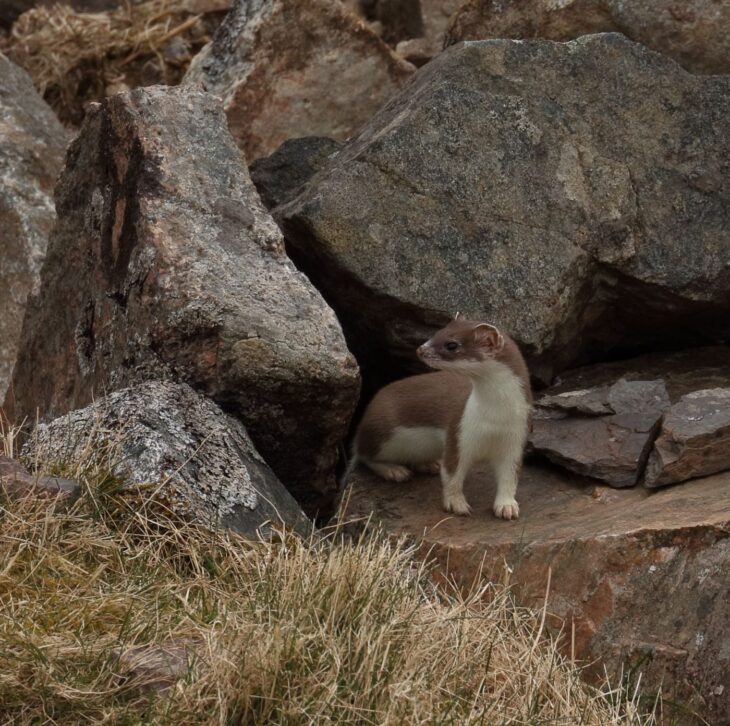
While the trees are bare, it gives you a good chance to really get to see bracket Fungi and lichens. Although they are there all year round, it often takes a few minutes to start to see the species types and colours between the leaves and flowers. Now is a great time to start to get to grips with some common lichens and fungi. Try the ones below:
- Hoof Bracket Fungus (Fomes fomentarius, aka tinder fungus) – mainly found on birch trees. Similarly to trees the
ridges correspond to annual growth periods.
In the spring, one of these fruiting bodies can produce up to 887 million spores an hour, visible as white powder! - Beard Lichen (Usnea subfloridana) – Widespread across the British isle but is found on trees, mainly growing on twigs rather than the trunk. One of most tolerant lichen species to pollution in Britain.
- Tree Lungwort (Lobarina pulmonaria) – Found on broad leaved trees, heather species and mossy rocks. It is considered an old forest indicator, particularly as it is slow to recolonise an area. Once sold as a cure for lung diseases, giving it its name.
- Dog Lichen (Peltigera spp) – Found in lawns, wet areas, and acidic soils including peat. Look for the white ‘teeth’ on the underside of the lichen.
- Smooth Loop Lichen (Hypotrachyna laevigata) – Found in damp woodland on the west coast (needs a high rainfall area). Often growing over moss on trees or rocks. Several similar species that take a magnifying glass to determine the differences.
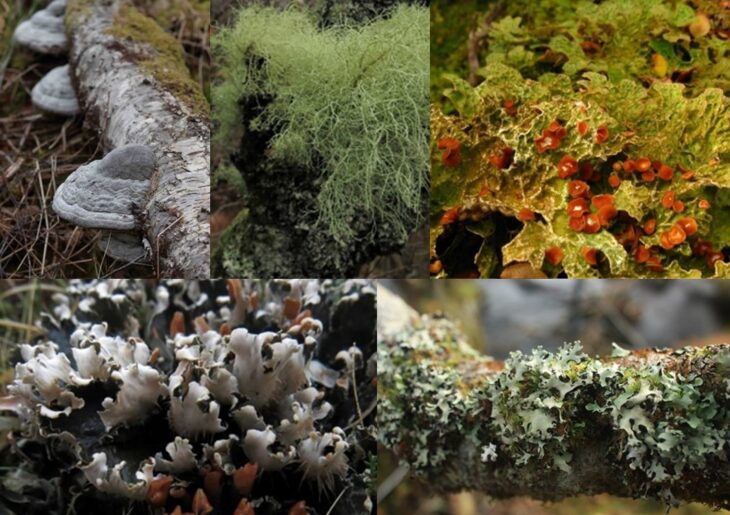
We hope you enjoy the start of 2020 and have a great wildlife spotting year!
Please remember to always enjoy the wildlife responsibly
